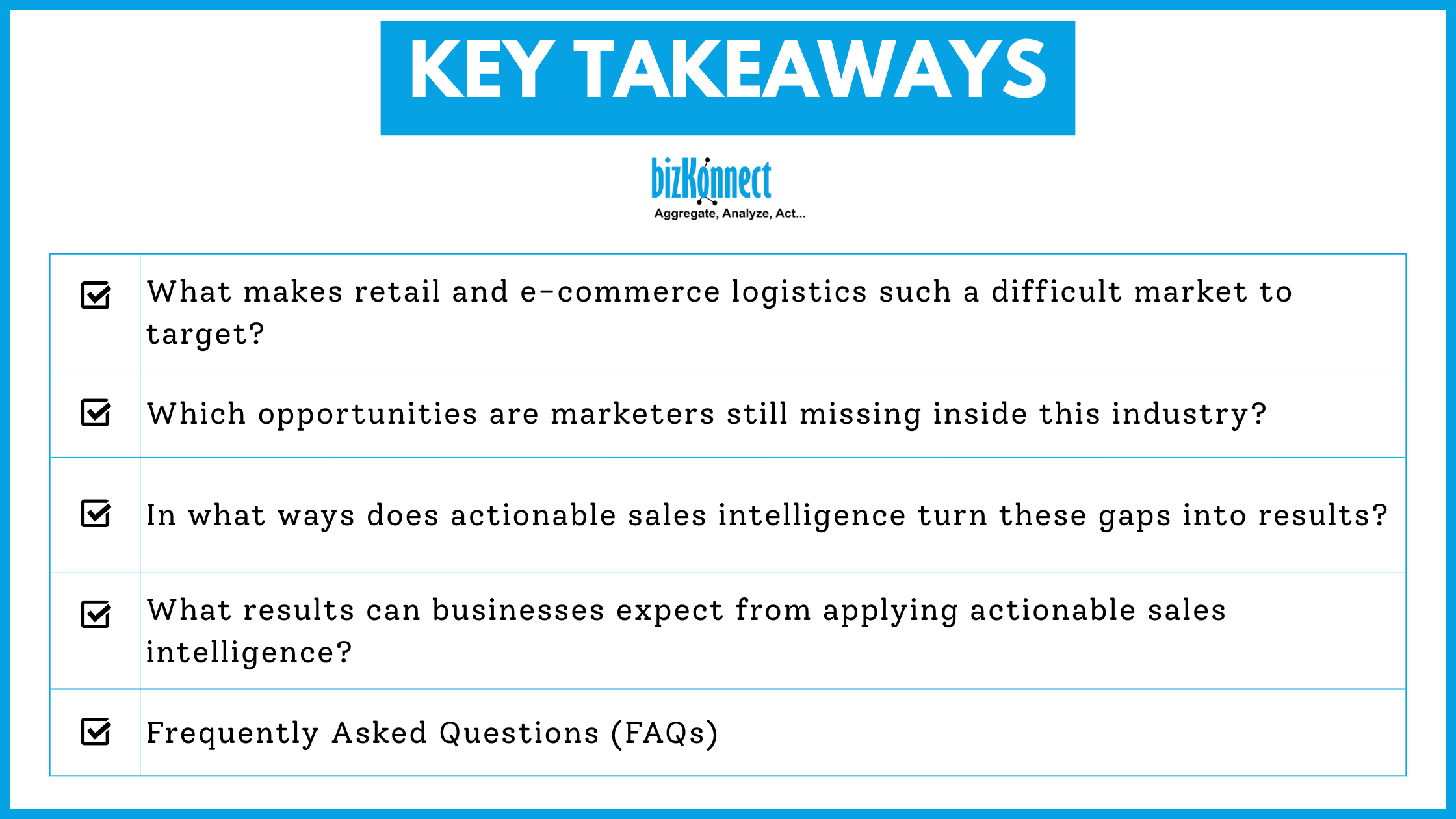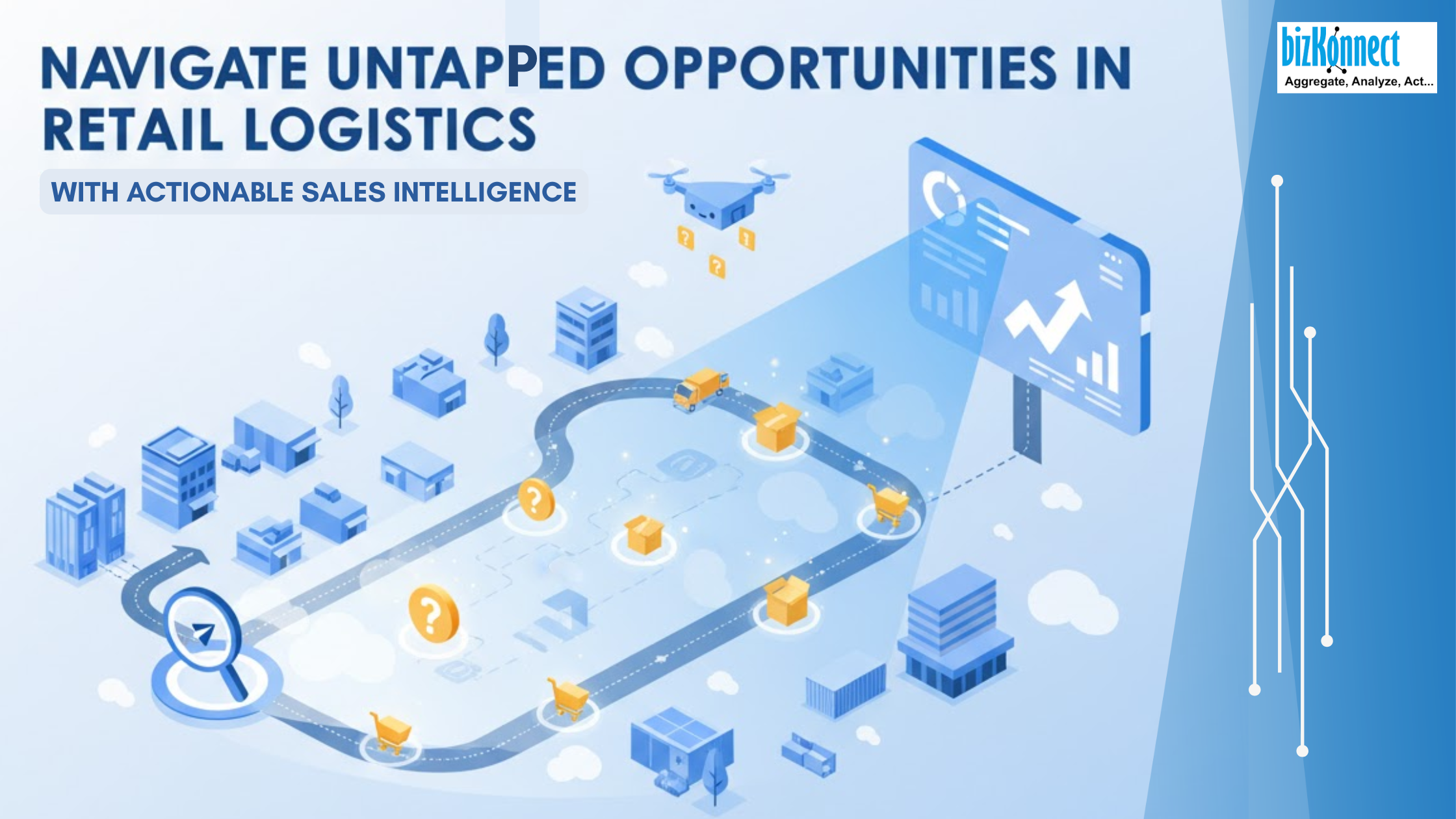In the retail and e-commerce logistics space, the real opportunity no longer lies in who moves goods fastest, but in who understands who makes those movements possible. Marketers today are reaching inboxes, but not decision rooms. They create content for brands and retailers while overlooking the third-party logistics (3PL) leaders, warehouse planners, and last-mile heads who actually influence purchase decisions.
This disconnect persists because campaigns are built on incomplete or outdated data, the kind that lists names but not intentions, firmographics, or context. Actionable sales intelligence changes that. It transforms static data into contextual insight: who’s expanding fulfillment capacity, who’s adopting automation, who’s struggling with returns, and who’s investing in sustainability.

It also integrates enriched organizational knowledge, dynamic org charts, and CRM-ready contact data designed for retail and e-commerce logistics, helping marketers identify operational decision-makers such as warehouse heads, 3PL managers, and last-mile coordinators.
When marketers use this data to drive outreach, they move from being “seen” to being selected.
What makes retail and e-commerce logistics such a difficult market to target?
Because its decision ecosystem is fragmented. A single retail logistics network can involve brand procurement teams, warehouse managers, technology integrators, and sustainability officers: each with separate objectives and budgets. Campaigns that address them as one audience often miss all of them.
Marketers also tend to overemphasize delivery speed or cost per order. Yet the real conversations inside retail logistics firms revolve around capacity utilization, regulatory compliance, real-time visibility, and reverse logistics. Those metrics that define profit margins, not marketing slogans.
A recent report valued India’s logistics sector at USD 215 billion in 2021, projected to grow 10.7% annually through 2026, driven by e-commerce fulfillment and returns. Yet, most marketing materials for logistics SaaS or partnerships still treat the retail industry as an operational afterthought and not a growth engine.
This is where actionable sales intelligence makes the difference: it identifies who manages these functions, which technologies they rely on, and what signals they are giving off right now. It also empowers marketers to segment by geography, operational role, and vertical, ensuring that campaigns reach warehouses, 3PL operators, and last-mile teams with messaging relevant to their day-to-day challenges.
Which opportunities are marketers still missing inside this industry?
Several, and they share one trait: they are operationally obvious but commercially invisible.
- Missing the 3PL Decision-Makers: Campaigns focus on retail procurement heads instead of logistics operations, planning, or tech leads. Sales intelligence surfaces these hidden influencers by mapping organizational hierarchies and responsibilities. Dynamic org charts now allow marketers to visualize relationships between warehouse heads, 3PL operators, and last-mile coordinators, ensuring outreach reaches the true decision-makers.
- Ignoring Reverse Logistics and Returns: Returns in Indian e-commerce can range from 20-30% in certain categories. Yet few marketers frame their solution in terms of RTO (Return to Origin) cost reduction or reverse routing efficiency. Actionable intelligence identifies which e-commerce retailers experience high return ratios and where optimization budgets exist, enabling campaigns to address these pain points directly.
- Underplaying Data Integration Gaps: Many logistics providers operate fragmented systems such as multiple WMS (Warehouse Management Systems) and TMS (Transport Management Systems) that don’t sync. Sales intelligence for CRM data enrichment ensures that all operational data is centralized, enabling targeted messaging to the right warehouse, 3PL, and last-mile contacts and making outreach actionable rather than generic.
- Overlooking Sustainability and Compliance: As India’s e-commerce scales, so does regulation. Packaging norms, emissions tracking, and waste compliance are real cost centres. By identifying logistics firms prioritizing ESG (Environmental, Social, and Governance) investments, marketers can position campaigns around sustainability initiatives while highlighting ROI impact.
- Not Segmenting by Region or Category: The logistics needs of Tier-3 cities differ sharply from metros. Similarly, FMCG logistics differs from fashion or electronics. Actionable sales intelligence enables micro-segmentation by geography, product vertical, and operational role. This ensures messaging resonates with warehouses, 3PLs, and last-mile teams based on their specific challenges.

In what ways does actionable sales intelligence turn these gaps into results?
It does this through contextual awareness and timing accuracy.
- Intent Tracking: Identifies logistics firms expanding warehouse capacity, hiring automation specialists, or opening new regional hubs.
- Technographic Insights: Shows which 3PLs already use specific ERP or warehouse platforms, helping marketers tailor integration messages.
- Trigger Alerts: Notifies sales teams when prospects announce new partnerships, sustainability initiatives, or return management programs.
- CRM Enrichment: Keeps databases current, eliminating redundancy and aligning outreach with verified decision contacts.
Retail and ecommerce logistics companies leveraging AI-powered analytics deliver higher operational efficiency and shorter sales cycles when partners use data-driven targeting. By integrating enriched org data, CRM-ready contacts, and micro-segmentation solutions, actionable intelligence ensures every marketing campaign connects with operational stakeholders in retail and e-commerce logistics, maximizing relevance, engagement, and conversions.
What results can businesses expect from applying actionable sales intelligence?
When campaigns align with contextual operational data:
- Conversion rates rise because outreach matches current business needs.
- Engagement improves as content reflects actual pain points (RTO, compliance, API integration).
- Sales teams spend less time qualifying and more time conversing.
For marketers targeting logistics, the benefit is twofold: better pipeline accuracy and stronger partner credibility. These are the tangible benefits of sales intelligence for sales teams in retail and e-commerce logistics when used strategically.
Frequently Asked Questions (FAQs)
Q1. What is the most overlooked trend shaping retail and ecommerce logistics marketing?
The rise of reverse logistics and return-to-origin (RTO) management as a strategic cost centre, not just a service function.
Q2. How does actionable sales intelligence support campaign targeting for this industry?
It combines firmographic and intent data with technographic insights, revealing who is expanding warehouses, upgrading systems, or adopting automation.
Q3. How does this approach differ from traditional lead generation?
Traditional lists stop at contact details. Sales intelligence adds buying signals, technology context, and operational triggers that indicate readiness to engage.
Q4. What measurable results can marketers expect from using B2B sales intelligence?
Higher engagement rates, shorter qualification cycles, and more conversions from 3PL and e-commerce accounts due to precise persona targeting.
Q5. How do retail & e-commerce-specific data capabilities improve outreach?
Enriched org charts, CRM integration, and micro-segmentation help marketers reach warehouses, 3PLs, and last-mile teams with tailored campaigns addressing their operational challenges.
See what high-conversion contact data looks like. Get a free sample from BizKonnect.